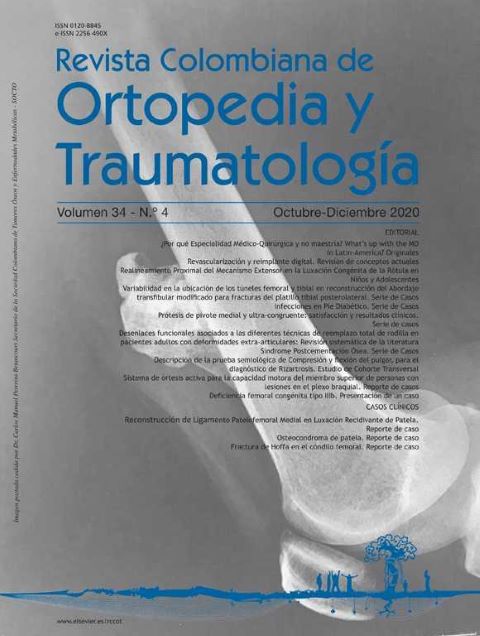Diabetic Foot Infections. Case Series
DOI:
https://doi.org/10.1016/j.rccot.2020.09.007Keywords:
diabetic foot infections, diabetic foot treatment, micro-organisms in diabetic foot, diabetic foot, osteomyelitisAbstract
Background: The main purpose of the study is to describe the clinical characteristics, microorganisms isolated in specimens taken in the operating room, types of surgical procedures, and outcomes in treatments performed on patients with diabetic foot.
Methods: A case series study is presented, describing results obtained from cultures taken in surgery, clinical characteristics according to Wagner’s classification, and number and type of procedures performed between January 2012 and December 2016 due to complications derived from diabetic foot.
Results: The study included 58 patients, with a mean age of 65 years, and 69% were men. The clinical stage in the pre-surgical evaluation was 39.7% and 37.9% Wagner III and IV, respectively, and during the operation it was 32.8% III, 50% IV. The isolated micro-organisms were 15.5% Escherichia Coli, of these 11.9% were ESBL positive and 3.6% multisensitive. Another 15.5% were Pseudomonas Aeruginosa, multiresistant variants 10.7%, producing carbapenemases 1.2%, resistant to meropenem 1.2%, and multiple sensitivity 2.4%. The large majority (77.5%) of the patients required a change of antibiotic. One third of the patients required major amputations, of which 46.6% had infections caused by multidrug-resistant germs.
Discussion: The predominant micro-organisms found were multi-resistant gram negative bacilli. It is suggested taking specimens intraoperative prior to the start of antibiotic therapy. Given the bacterial flora isolated in this series, when starting empirical antibiotic therapy, the use of carbapenems is suggested.
Evidence Level: IV
Downloads
References
Martínez-Gómez DDA, Ramírez-Almagro C, Campillo-Soto Á, Morales-Cuenca G, Pagán-Ortiz J, Aguayo-Albasini JL. Infecciones del pie diabético. Prevalencia de los distintos microorganismos y sensibilidad a los antimicrobianos. Enferm Infecc Microbiol Clin. 2009;27:317-21, https://doi.org/10.1016/j.eimc.2008.07.004
Lipsky BA. A report from the international consensus on diagnosing and treating the infected diabetic foot. Diabetes Metab Res Rev. 2004;20 SUPPL. 1:68-77, https://doi.org/10.1002/dmrr.453
Graffunder EM, Venezia RA. Risk factors associated with nosocomial methicillin-resistant Staphylococcus aureus (MRSA) infection including previous use of antimicrobials. J Antimicrob Chemother. 2002;49:999-1005. https://doi.org/10.1093/jac/dkf009
Boulton AJM, Kirsner RS, Vileikyte L. Neuropathic Diabetic Foot Ulcers. N Engl J Med. 2004;351:48-55, https://doi.org/10.1056/NEJMcp032966
EM G, RA V. Risk factors associated with nosocomial methicillinresistant Staphylococcus aureus (MRSA) infection including previous use of antimicrobials. J Antimicrob Chemother. 2002;49(6):999-1005. https://doi.org/10.1093/jac/dkf009
Richard J-L, Sotto A, Jourdan N, et al. Risk factors and healing impact of multidrug-resistant bacteria in diabetic foot ulcers. DIABETES Metab. 2008;34:363-9,https://doi.org/10.1016/j.diabet.2008.02.005
Wagner FW. The dysvascular foot: a system for diagnosis and treatment. Foot Ankle. Foot Ankle Int. 1981;2:64-122, https://doi.org/10.1177/107110078100200202
Biomerieux. http://www.biomerieux.com/en/identificationand-antibiotic-susceptibility-testing.
CLSI. Performance Standards for Antimicrobial Disk Susceptibility Tests; Approved Standard-Eleventh Edition. CLSI Document M02-A11. Wayne, PA: Clinical and Laboratory Standards Institute; Vol 32.; 2012. doi:M02-A11.
Moura Neto A, Zantut-Wittmann DE, Parisi MCR, Fernandes TD, Nery M. Risk factors for ulceration and amputation in diabetic foot: Study in a cohort of 496 patients. Endocrine. 2013;44:119-24, https://doi.org/10.1007/s12020-012-9829-2
Stratton IM, Adler AI, Neil HAW, et al. Association Of Glycaemia With Macrovascular And Microvascular Complications Of Type 2 Diabetes (UKPDS 35): Prospective Observational Study. BMJ Br Med J. 2000;321:405. https://doi.org/10.1136/bmj.321.7258.405
Almaramhy H, Mahabbat NA, Fallatah KY, Al-Ahmadi BA, AlAlawi HH, Guraya SY. The correlation of fasting blood glucose levels with the severity of diabetic foot ulcers and the outcome of treatment strategies. Biomed Res. 2018;29:1961-7. https://doi.org/10.4066/biomedicalresearch.29-18-502
Slater RA, Lazarovitch T, Boldur I, et al. Swab cultures accurately identify bacterial pathogens in diabetic foot wounds not involving bone. Diabet Med. 2004;21:705-9, https://doi.org/10.1111/j.1464-5491.2004.01221.x
Kandemir Ö, Akbay E, S¸ahin E, Milcan A, Gen R. Risk factors for infection of the diabetic foot with multi-antibiotic resistant microorganisms. J Infect. 2007;54:439-45, https://doi.org/10.1016/j.jinf.2006.08.013
Gerding DN. Foot infections in diabetic patients: the role of anaerobes. Clin Infect Dis. 1995;20 Suppl 2:S283-8. https://doi.org/10.1093/clinids/20.Supplement_2.S283
Lipsky BA, Armstrong DG, Citron DM, Tice AD, Morgenstern DE, Abramson MA. Ertapenem versus piperacillin/tazobactam for diabetic foot infections (SIDESTEP): Prospective, randomised, controlled, doubleblinded, multicentre trial. Lancet. 2005;366:1695-703, https://doi.org/10.1016/S0140-6736(05)67694-5
Crouzet J, Lavigne JP, Richard JL, Sotto A. Diabetic foot infection: A critical review of recent randomized clinical trials on antibiotic therapy. Int J Infect Dis. 2011;15:e601-10, https://doi.org/10.1016/j.ijid.2011.05.003
Jones RN, Marshall WP. Does the Proximity of an Amputation. Length of Time Between Foot Ulcer Development and Amputation, or Glycemic Control at the Time of Amputation Affect the Mortality Rate of People with Diabetes who Undergo an Amputation? Adv Skin Wound Care. 2008;21:118-23, https://doi.org/10.1097/01.ASW.0000305419.73597.5f
Harkless L, Boghossian J, Pollak R, et al. An Open-Label, Randomized Study Comparing Efficacy and Safety of Intravenous Piperacillin/Tazobactam and Ampicillin/Sulbactam for Infected Diabetic Foot Ulcers. Surg Infect (Larchmt). 2005;6:27-40, https://doi.org/10.1089/sur.2005.6.27
Lipsky BA, Holroyd KJ, Zasloff M. Topical versus Systemic Antimicrobial Therapy for Treating Mildly Infected Diabetic Foot Ulcers: A Randomized, Controlled, Double-Blinded. Multicenter Trial of Pexiganan Cream. Clin Infect Dis. 2008;47:1537-45, https://doi.org/10.1086/593185
Lipsky BA, Armstrong DG, Citron DM, Tice AD, Morgenstern DE, Abramson MA. Ertapenem versus piperacillin/tazobactam for diabetic foot infections (SIDESTEP): prospective, randomised, controlled, double-blinded, multicentre trial. Lancet (London, England). 2005;366:1695-703, https://doi.org/10.1016/S0140-6736(05)67694-5
Lipsky BA, Itani K, Norden C, Linezolid Diabetic Foot Infections Study Group. Treating Foot Infections in Diabetic Patients: A Randomized, Multicenter, Open-Label Trial of Linezolid versus Ampicillin-Sulbactam/Amoxicillin-Clavulanate. Clin Infect Dis. 2004;38:17-24, https://doi.org/10.1086/380449
File TM. Highlights from 2012 infectious diseases society of America clinical practice guidelines for the diagnosis and treatment of diabetic foot infections. Infect Dis Clin Pract. 2013;21:43-5, https://doi.org/10.1097/IPC.0b013e318278f3e6





